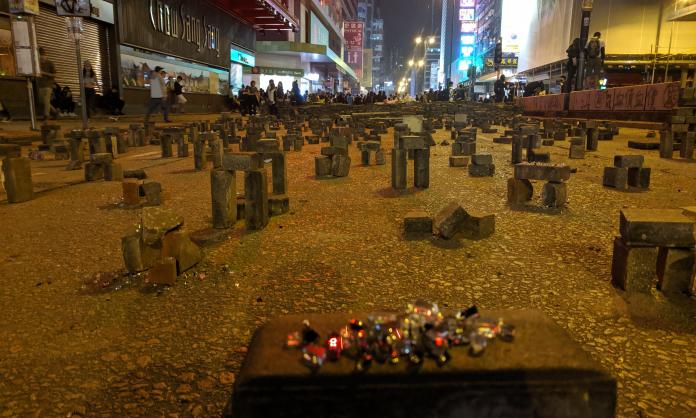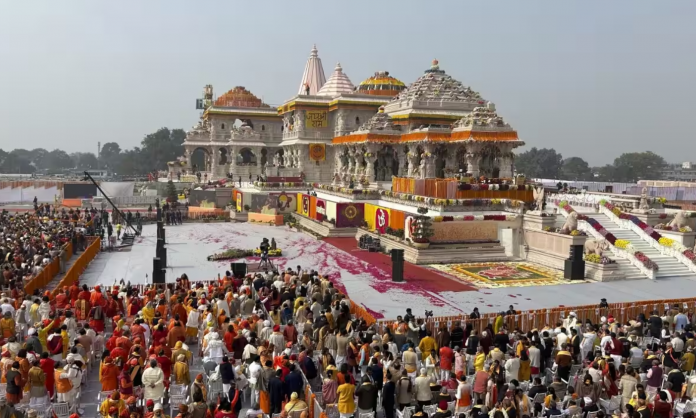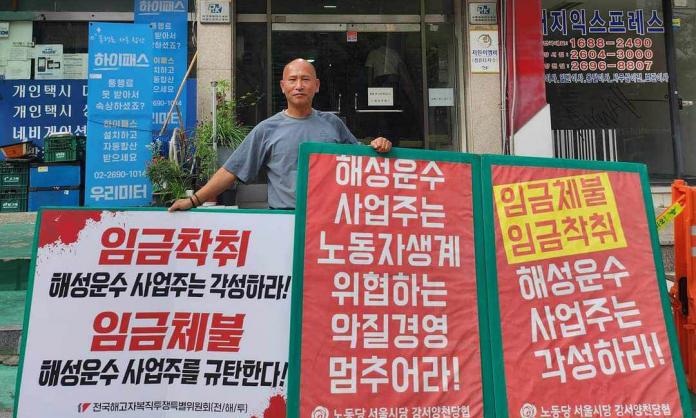There have been explosions at the number two bridge at the Chinese University of Hong Kong (CUHK) and the metro is shutting down at 10pm. The East rail line is partially open, but the last train from the Polytechnic University at Hung Hom is going only as far as Fo Tan, the stop before University station, which has been destroyed by the students. At Fo Tan, a taxi driver waves his hands in the air and shakes his head. He’s not going anywhere near the campus. A couple of young people say it’s only a 30-minute walk but don’t worry – they will send a message out to get a car. Their friend is here within five minutes and will get me as close as he can.
Wo is a recent graduate and explains the situation on the way. This morning, the students opened a lane each way on the Tolo highway as a gesture to locals and to reiterate that the blame for all the chaos lies with the government. Tolo has been blockaded for several days because it is an important arterial linking the New Territories with the city. A lot of workers use it to commute, though, and the students don’t want to start pissing them off. Whoever negotiated the opening allegedly gave a 24-hour ultimatum for the government to guarantee that the impending council elections will go ahead. “I don’t know why they did this – no-one cares about these elections and they have never been part of our demands”, Wo says. When the general student population found out, they instead gave a 24-hour ultimatum for the fulfillment of the five demands. After nightfall, they shut down Tolo again.
But whatever’s happened with the explosion, the campus is being evacuated by the activists. The vice chancellor sent out a letter today as well. He is threatening to officially call the police in to clear the campus if the activists don’t leave. Tai Po road, which leads to the university, is a log jam. “All these cars have responded to the call to get people out”, says Wo. “They are the parents.” They’re not real parents, although some may be. Parent is the name given to those in the movement, like Wo, who volunteer to get people in and out of places quickly. Often, it’s getting people home safely after demonstrations when the transit system has been shut down or in the early hours of the morning so they don’t get taken by cops or beaten by thugs.
Nothing is moving, so I have to walk the last part of the way. The barricade at Lai Ping Road is being dismantled rapidly to get the cars in. There’s a large commercial removal truck. The most useful parts of the barricade are loaded in, along with other material being brought from up the road. At the campus entrance, a student stands with several boxes of Molotov cocktails. “I’m not sure why. There was a van explosion at number two bridge”, he says. Was it the police? Was anyone hurt? “No, but we had no defence. There were not enough people to rebuild. Without the bridge, there is no point staying and fighting. We will lose. Most people have gone now. Before the police come.” Are they giving up? “No. We are taking as much as we can to other universities to reinforce them.” That explains the pace at which people are moving.
For the fourth night in a row there are protests in town. I wave down the first scooter to come past. “Can you take me to Mong Kok?” Such is the support for the movement that nothing else needs be said. He pulls out a helmet and we’re off at a cracking pace. The streets are again occupied, bricks again litter the place and the barricades are up at Nathan and Mong Kok roads. There are no police, but they were here earlier. In the middle of the intersection the front liners make more Molotovs. Someone stuffs it up and the road is on fire. The culprit pretends to have done it on purpose and rubs his hands above the flames as though he is just trying to warm up on this balmy night. Everyone finds this very funny.
The numbers and intensity are well down from Tuesday night. And barricades are more rudimentary; firefighters walk in unchallenged to put out small fires. When, after midnight, the police come firing tear gas and advancing south along Nathan, only 30-40 of them are needed to push everyone back. The front line fighters get the umbrellas up and launch a volley of Molotovs. But they are probably outnumbered even by the international press corps, whose numbers have swelled significantly over the last two days. Tonight, there is no strung-out advance-and-retreat battle. The cops just steadily move forward, firing tear gas every now and again and barking instructions. Then they leave as quickly as they arrived.
Over the last few days, everything seemed to be heading for a decisive confrontation. But police have so far not come out hard. For two days, the cross-channel tunnel has been blocked by the Polytechnic students and no attempt has been made to reopen it. The government appears to be in a bind. The students have overwhelming support, and hostility to the police has only grown since they lashed out at CUHK and Mong Kok on Tuesday night. But Beijing continues to demand a crack down. The Hong Kong government has so far been unwilling to smash the students, likely fearing such a move will provoke a city-wide confrontation that they cannot control. It is significant that the only pro-cop counter-mobilisations calling for the restoration of order attract several hundred at most.
I haven’t made it to Central on Hong Kong Island yet, where demonstrations happen every day at lunchtime. Sue Sparks, a socialist formerly based in Hong Kong and who is following events here, noted on Thursday: “We see plenty of workers joining protests, including office workers in financial services, lawyers, accountants, IT workers, retail workers (HK no longer has any manufacturing) ... As individuals they take days off, often with the sympathy of the bosses”. Reports suggest that these protests continue to grow and the government is threatening public service employees with suspension if they get too involved.
On a side street, the intersection of Shantung and Shanghai streets, a small group is smashing the traffic lights. One protester is unperturbed about the loss of CUHK tonight. Isn’t this the central campus to hold? “I’m not worried. We have so much support and other campuses”, he says. “Maybe the [CUHK] students are tired. But the population is not. I feel things have shifted in the last days. Two elderly Mandarin-speaking women (i.e. Mainlanders) yesterday saw me in this mask. They said stay safe. That to me is very unusual. It says we are getting even more support. And there was an elderly man with a [walking] frame. I started to clear the bricks for him to get a path, but he said no don’t do that they’ll catch you and beat you.”
The group of traffic light smashers now turns its attention to a branch of China CITIC Bank International. Before long, the place is ablaze and bystanders are cheering and chanting “Fuck China!” But it’s 2am and things are petering out. The bank is burning, the cops are moving in again, but things are settling down. With the CUHK activists and some of their materials redeploying to the Polytechnic and other occupations, the ball is in the government’s court.










